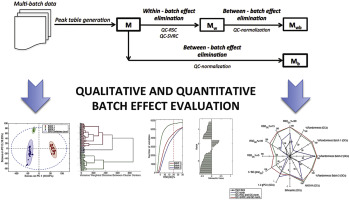当前位置:
X-MOL 学术
›
Anal. Chim. Acta
›
论文详情
Our official English website, www.x-mol.net, welcomes your feedback! (Note: you will need to create a separate account there.)
Evaluation of batch effect elimination using quality control replicates in LC-MS metabolite profiling
Analytica Chimica Acta ( IF 6.2 ) Pub Date : 2018-08-01 , DOI: 10.1016/j.aca.2018.02.053 Ángel Sánchez-Illana , Jose David Piñeiro-Ramos , Juan Daniel Sanjuan-Herráez , Máximo Vento , Guillermo Quintás , Julia Kuligowski
Analytica Chimica Acta ( IF 6.2 ) Pub Date : 2018-08-01 , DOI: 10.1016/j.aca.2018.02.053 Ángel Sánchez-Illana , Jose David Piñeiro-Ramos , Juan Daniel Sanjuan-Herráez , Máximo Vento , Guillermo Quintás , Julia Kuligowski

|
Systematic variation of the instrument's response both within- and between-batches is frequently observed in untarget LC-MS metabolomics involving the analysis of a large number of samples. The so-called batch effect decreases the statistical power and has a negative impact on repeatability and reproducibility of the results. As there is no standard way of assessing or correcting LC-MS batch effects and there is no single method providing optimal results in all situations, the selection of the optimal approach is not trivial. This work explores the effectiveness of a set of tools for batch effect assessment. Qualitative tools include the monitoring of spiked internal standards, principal component analysis and hierarchical cluster analysis. Quantitative tools comprise the distribution of RSDQC values, the median Pearson correlation coefficient in QCs, the ratio of random features in QCs using the runs test, as well as multivariate tools such as the δ-statistic, Silhouette plots, Principal Variance Component Analysis and the expected technical variation in the prediction. Results show that qualitative and quantitative approaches are complementary and that by limiting the analysis to QCs the power to detect and evaluate both within and between batch effects is increased. Besides, the graphical integration of outputs from multiple quantitative tools facilitates the evaluation of batch effects and it is proposed as a straightforward way for comparing and tailoring batch effect elimination approaches.
中文翻译:

在 LC-MS 代谢物分析中使用质量控制重复评估批次效应消除
在涉及大量样品分析的非目标 LC-MS 代谢组学中,经常观察到仪器在批次内和批次间响应的系统变化。所谓的批次效应会降低统计功效,并对结果的重复性和再现性产生负面影响。由于没有评估或校正 LC-MS 批次效应的标准方法,也没有单一方法可以在所有情况下提供最佳结果,因此选择最佳方法并非易事。这项工作探索了一组用于批量效果评估的工具的有效性。定性工具包括监测加标内标、主成分分析和层次聚类分析。定量工具包括 RSDQC 值的分布,QC 中的中值 Pearson 相关系数、QC 中使用运行测试的随机特征的比率,以及多变量工具,如 δ 统计量、剪影图、主方差分量分析和预测中的预期技术变异。结果表明,定性和定量方法是互补的,通过将分析限制为 QC,可以提高检测和评估批次内和批次间效应的能力。此外,来自多个定量工具的输出的图形集成有助于评估批次效应,并被提议作为比较和定制批次效应消除方法的直接方法。主方差分量分析和预测中的预期技术变异。结果表明,定性和定量方法是互补的,通过将分析限制为 QC,可以提高检测和评估批次内和批次间效应的能力。此外,来自多个定量工具的输出的图形集成有助于评估批次效应,并被提议作为比较和定制批次效应消除方法的直接方法。主方差分量分析和预测中的预期技术变异。结果表明,定性和定量方法是互补的,通过将分析限制为 QC,可以提高检测和评估批次内和批次间效应的能力。此外,来自多个定量工具的输出的图形集成有助于评估批次效应,并被提议作为比较和定制批次效应消除方法的直接方法。
更新日期:2018-08-01
中文翻译:

在 LC-MS 代谢物分析中使用质量控制重复评估批次效应消除
在涉及大量样品分析的非目标 LC-MS 代谢组学中,经常观察到仪器在批次内和批次间响应的系统变化。所谓的批次效应会降低统计功效,并对结果的重复性和再现性产生负面影响。由于没有评估或校正 LC-MS 批次效应的标准方法,也没有单一方法可以在所有情况下提供最佳结果,因此选择最佳方法并非易事。这项工作探索了一组用于批量效果评估的工具的有效性。定性工具包括监测加标内标、主成分分析和层次聚类分析。定量工具包括 RSDQC 值的分布,QC 中的中值 Pearson 相关系数、QC 中使用运行测试的随机特征的比率,以及多变量工具,如 δ 统计量、剪影图、主方差分量分析和预测中的预期技术变异。结果表明,定性和定量方法是互补的,通过将分析限制为 QC,可以提高检测和评估批次内和批次间效应的能力。此外,来自多个定量工具的输出的图形集成有助于评估批次效应,并被提议作为比较和定制批次效应消除方法的直接方法。主方差分量分析和预测中的预期技术变异。结果表明,定性和定量方法是互补的,通过将分析限制为 QC,可以提高检测和评估批次内和批次间效应的能力。此外,来自多个定量工具的输出的图形集成有助于评估批次效应,并被提议作为比较和定制批次效应消除方法的直接方法。主方差分量分析和预测中的预期技术变异。结果表明,定性和定量方法是互补的,通过将分析限制为 QC,可以提高检测和评估批次内和批次间效应的能力。此外,来自多个定量工具的输出的图形集成有助于评估批次效应,并被提议作为比较和定制批次效应消除方法的直接方法。



























 京公网安备 11010802027423号
京公网安备 11010802027423号